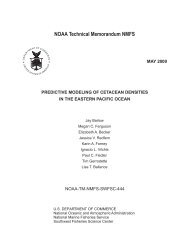NOAA Technical Memorandum NMFS - Southwest Fisheries ...
NOAA Technical Memorandum NMFS - Southwest Fisheries ...
NOAA Technical Memorandum NMFS - Southwest Fisheries ...
Create successful ePaper yourself
Turn your PDF publications into a flip-book with our unique Google optimized e-Paper software.
significantly larger than the mean group size of 69.7 for visual (only) dolphin schools<br />
(Mann-Whitney test, U=774, p=0.006, Table 12).<br />
Tursiops truncatus, the common bottlenose dolphin, was encountered throughout<br />
much of the temperate and tropical survey area south of central California (Fig. 26).<br />
There were a total of 75 visual detections of T. truncatus during the combined surveys, of<br />
which 82.7% produced vocalizations detected by the acoustics team (Table 9, Fig. 19).<br />
The mean acoustic detection distance was 1.79 nmi (SD ± 1.33), with a maximum<br />
detection distance of 6 nmi (Table 10). T. truncatus was found to produce whistles,<br />
echolocation clicks, and burst pulses (Fig. 20). Nearly all (96.7%) of acoustic detections<br />
of T. truncatus included whistles, and 77% of detections included echolocation clicks<br />
and/or burst pulses (Table 11). The mean group size for vocal schools of T. truncatus<br />
was 78.1 animals, which was significantly larger than the mean group size of 10.1 for<br />
visual (only) dolphin schools (Mann-Whitney test, U=237.5, p=0.02, Table 12).<br />
Stenella longirostris, the spinner dolphin, was encountered in the tropical waters<br />
of the Pacific Ocean (Fig. 27). There were a total of 46 visual detections of S.<br />
longirostris during the combined surveys, of which 80.4% produced vocalizations<br />
detected by the acoustics team (Table 9, Fig. 19). The mean acoustic detection distance<br />
was 2.61 nmi (SD ± 1.55), with a maximum detection distance of 6 nmi (Table 10). S.<br />
longirostris was found to produce whistles, echolocation clicks, and burst pulses (Table<br />
11). All acoustic detections of S. longirostris included whistles, and 37.8% of detections<br />
included echolocation clicks and/or burst pulses (Fig. 20). The mean group size for vocal<br />
schools of S. longirostris was 116.4 animals, which was significantly larger than the<br />
mean group size of 38.1 for visual (only) dolphin schools (Mann-Whitney test, U=71,<br />
p=0.008, Table 12).<br />
Stenella coeruleoalba, the striped dolphin, was encountered throughout most of<br />
the warm-temperate and tropical Pacific Ocean (Fig. 28). There were a total of 192<br />
visual detections of S. coeruleoalba during the combined surveys, of which 79.2%<br />
produced vocalizations detected by the acoustics team (Table 9, Fig. 19). The mean<br />
acoustic detection distance was 2.63 nmi (SD ± 1.84), with a maximum detection<br />
distance of 10 nmi (Table 10). S. coeruleoalba were found to produce whistles,<br />
echolocation clicks, and burst pulses (Fig. 20). All acoustic detections of S. coeruleoalba<br />
included whistles, and 25% of detections included echolocation clicks and/or burst pulses<br />
(Table 11). The mean group size for vocal schools of S. coeruleoalba was 60.5 animals,<br />
which was significantly larger than the mean group size of 48.3 for visual (only) dolphin<br />
schools (Mann-Whitney test, U=2175, p=0.047, Table 12).<br />
Stenella attenuata, the pantropical spotted dolphin, was encountered in the<br />
tropical waters of the Pacific Ocean (Fig. 29). There were a total of 105 visual detections<br />
of S. attenuata during the combined surveys, of which 77.1% produced vocalizations<br />
detected by the acoustics team (Table 9, Fig. 19). The mean acoustic detection distance<br />
was 1.85 nmi (SD ± 1.53), with a maximum detection distance of 6 nmi (Table 10). S.<br />
attenuata was found to produce whistles, echolocation clicks, and burst pulses (Table<br />
11). Nearly all (97.5%) of acoustic detections of S. attenuata included whistles, and 58%<br />
of detections included echolocation clicks and/or burst pulses (Fig. 20). The mean group<br />
size for vocal schools of S. attenuata was 93.2 animals, which was significantly larger<br />
than the mean group size of 41 for visual (only) dolphin schools (Mann-Whitney test,<br />
U=293.5, p=0.011, Table 12).<br />
9









